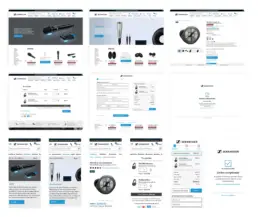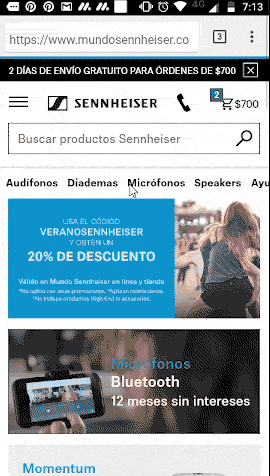Transforming E-Commerce Experience with a New Website for a Renowned Audio Company's High-Fidelity Products
Client
Mundo Sennheiser
Year
2021
My Role
UI/UX Designer
Tools
Adobe XD, PS, AI
Miro, Monday
Initial Problem Discovery
The client, an audio company specializing in the design and production of high-fidelity products, faced several issues with their e-commerce website. Firstly, the website was not optimized for selling, resulting in a difficult navigation experience, uninformative product pages, and a cumbersome checkout process. Consequently, the website was underperforming in terms of generating sales.
Furthermore, the website lacked proper inventory control, leading to frequent product unavailability and frustrated customers unable to complete their purchases.
Lastly, the website’s design was outdated and did not align with the brand identity of the main global brand, failing to portray the company’s modern image effectively.
Project Goal
To develop an e-commerce website that aligns seamlessly with the global company’s branding and provides a superior online shopping experience for customers of a renowned audio company, specializing in high-fidelity products.
Website design requirements
- Responsive design
- Brand Consistency
- Intuitive Navigation
- Informative Product Pages
- Streamlined Checkout Process
- Inventory Management
Target Audience
Audiophiles and Music Enthusiasts
Individuals who have a strong passion for high-quality audio and music, seeking premium audio products to enhance their listening experience.
Music Professionals and DJs
Professional musicians, DJs, and sound engineers in Mexico who rely on professional-grade microphones, wireless systems, and monitoring solutions for their performances, studio recordings, and live events.
Gaming and Sports Community
The growing gaming and esports community in Mexico, seek Sennheiser’s gaming headsets and audio accessories to enhance their gaming experience with immersive sound and clear communication.
Mobile and On-the-go Users
Tech-savvy individuals in Mexico who prioritize portability and convenience, choosing Sennheiser’s range of wireless earphones and headphones for enjoying music, podcasts, and other multimedia content while on the move.
Key Challenges or constraints
User Experience
Optimizing the website for mobile devices, considering the high mobile usage in Mexico, and ensuring a seamless and user-friendly experience across a variety of screen sizes and mobile operating systems.
Creating an intuitive and user-friendly interface, simplifying the checkout process, and optimizing the overall user experience to increase conversion rates and drive sales.
Brand Alignment:
Ensuring that the new e-commerce website aligns with the global brand guidelines and maintains consistency in terms of visual identity, tone of voice, and overall brand messaging.
Adapting the website to the local market in Mexico, including language translation, currency conversion, and culturally relevant content to resonate with the target audience.
Research Study Details
Competitor Analysis
Even though there are no other recipe apps from competitor companies, there are still many recipe apps that are important to review. By analyzing their features, we can identify essential features and differentiators.
Stakeholder interview
By talking to stakeholders, we could get insights into the needs, preferences, and expectations of different groups of people who would be using the app. This information could then be used to improve the app’s design, features, and content.
Personas creation
I created these fictional representations based on the information I was given and by doing research.
Design
During this stage, I developed wireframes, mockups, and high-fidelity prototypes.
Testing
Throughout the development of the e-commerce website for the audio company’s high-fidelity products, thorough testing was conducted to ensure a seamless user experience. A dedicated team of three individuals worked collaboratively to successfully complete purchases and identify areas for improvement.
The testing process involved simulating typical customer interactions, including product browsing and finalizing purchases. Various payment methods were tested, while inventory accuracy and integration with CRM and ERP systems were also verified.
Based on the testing, several key areas for improvement were identified:
- Streamlining the Checkout Process: Simplifying and optimizing the checkout process to enhance efficiency and user-friendliness.
- Enhancing Mobile Responsiveness: Optimizing the website for different mobile devices and screen sizes to provide a smooth experience for users on the go.
- Addressing Usability Issues: Gathering feedback from testing sessions to identify and resolve any usability issues or potential user confusion.
- Incorporating User Feedback: Integrating user feedback and preferences to iteratively improve the overall user experience.
By implementing these improvements, our aim is to create an e-commerce website that offers a satisfying and streamlined experience for customers. Ongoing testing and refinement will remain integral to maintaining and optimizing the website’s performance.
Insights gained from the project
- Usability Challenges: User feedback and testing revealed non-intuitive navigation and a complex checkout process, leading to high abandonment rates. Streamlining the user journey and simplifying the checkout steps became a priority.
- Branding Alignment: The previous website lacked effective alignment with the global company’s brand design, leading to consumer distrust despite being an official site. User feedback and brand guidelines emphasized the necessity of a redesign to establish consistency and reinforce the brand identity. This would enhance consumer confidence and trust in the website, resulting in improved user engagement and conversions.
- Inventory Management Issues: Testing uncovered inaccuracies in the website’s inventory control system, causing frustration for customers encountering out-of-stock items. Improving real-time updates and preventing product unavailability became a focus.
- Mobile Optimization Opportunities: Mobile testing exposed a need for better mobile responsiveness. User feedback and performance metrics emphasized the importance of optimizing the website’s mobile experience for the target audience’s high mobile usage.
These insights guided decision-making, prioritizing improvements to enhance usability, align with the brand, improve inventory management, and optimize mobile responsiveness.
















